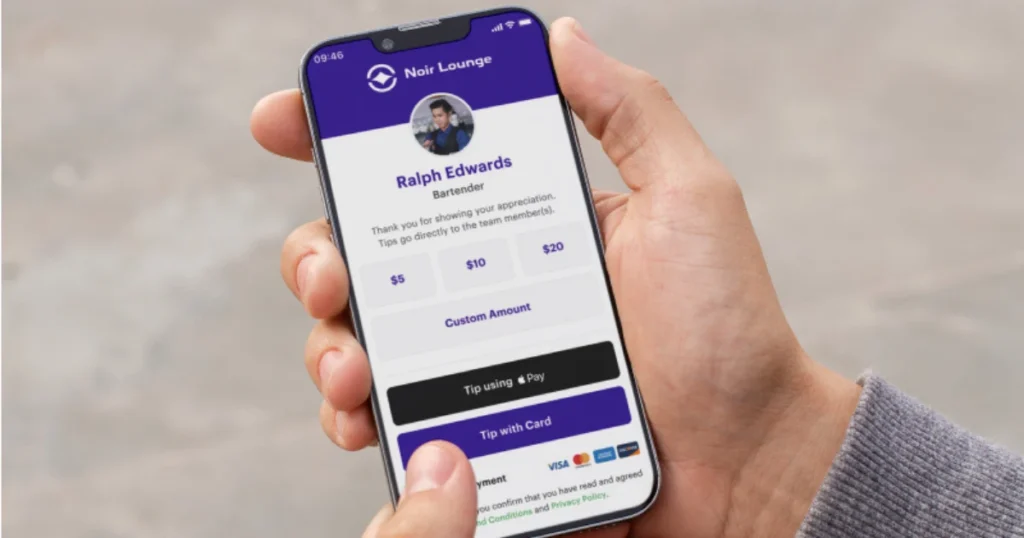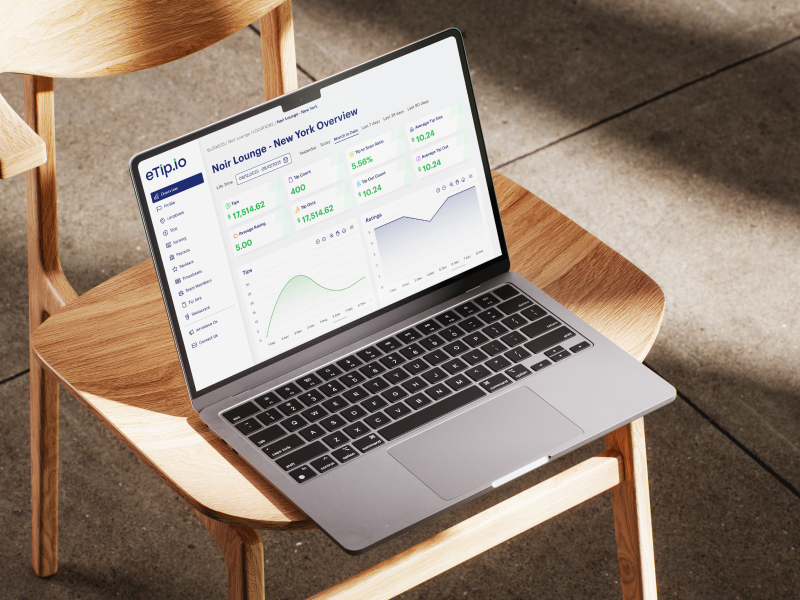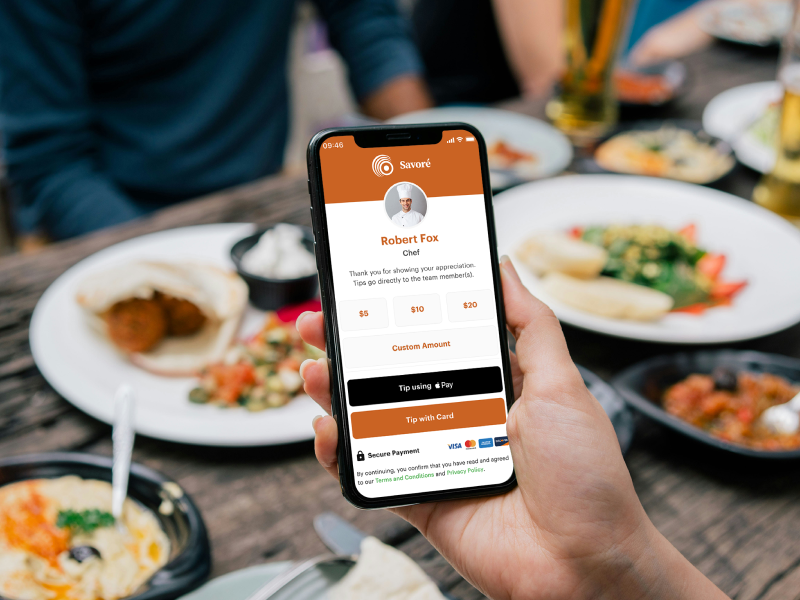Hospitality Businesses Need Contactless Tipping — Here’s Why

It should come as no surprise that fewer consumers carry cash these days. For service businesses that depend on tips, that shift matters.
Guests expect the same quick, digital ease when leaving a gratuity as they do when paying for a rideshare or their morning coffee. Tipping solutions like contactless tipping deliver exactly that — plus faster payouts for staff and less hassle for managers.
In this guide, we’re diving into what contactless tipping is, how it works, and why it’s essential at any hospitality business today.
Key takeaways
- Contactless tipping gives guests an easy way to show their appreciation without relying on cash.
- Operators benefit from faster tip distribution, less admin, and easier compliance.
- Staff see higher earnings and more frequent tips, leading to better retention.
- Clear policies and visible collateral are key when adopting contactless tipping.
- Choosing the right platform — like eTip — turns tipping into a powerful tool for guest and staff satisfaction.
What is contactless tipping?
First, let’s make sure we’re on the same page about what contactless tipping actually is.
Contactless tipping is a way for a customer to leave a gratuity without physical cash by using a digital platform, like a QR code, mobile wallet, or contactless credit/debit card. It’s a specific form of digital tipping, where guests don’t need to make contact with a PIN pad or other device (other than their own smartphone!)
Most of the time, contactless tipping is facilitated by a digital tipping system, which provides a front-end user interface for guests to leave a tip, and a back-end dashboard where operators can manage and distribute all tips.
Contactless tipping is on the rise — here’s why
Digital payments have steadily been replacing cash transactions for years. By 2019, only 26% of all payments in the U.S. were made in cash, down from 31% in 2016.
Then COVID hit and accelerated adoption of digital payments even faster. McKinsey found that the pandemic fast-tracked business digitization by nearly seven years in just a few months.
While health and safety concerns initially fueled the growth of contactless payments during the pandemic, both guests and businesses quickly realized there were broader advantages.
By accepting contactless payments:
- Guests could leave a tip even if they weren’t carrying cash.
- Staff got tips paid out faster and more reliably.
- Operators reduced the time they spent manually handling and distributing tips.
Keep in mind that contactless payment — and therefore contactless tipping — is becoming more and more of a must-have rather than a nice-to-have at service businesses. Forgoing it means you’re probably leaving money on the table or providing a less-than-ideal experience for guests and customers.
How contactless tipping works
There are a few different methods of enabling contactless tipping:
- QR tipping
Guests scan a QR code on a sign, receipt, table tent, name tag, or even a hotel room card. This is the most flexible, scalable option because you don’t have to buy and power any hardware. - Contactless tip machines
Devices placed on counters or tables that let guests “tap to tip” using their credit card or phone. They’re easy to use but require an investment in hardware and a power source, making it difficult to move them around from place to place. - Contactless tipping apps
Platforms where guests download an app to send tips digitally. The problem with these is that most customers aren’t willing to undergo the inconvenience of downloading an app just to leave a tip.
Benefits of contactless tipping
Cashless tipping is a nod to modern payment habits, but it also offers serious benefits for owners and managers.
Here’s what to expect from adopting contactless tipping at your business:
Convenience
Your customers don’t want to dig through their wallets for cash, and they definitely don’t want to hunt for an ATM (nobody likes ATM fees) just to tip the valet or slip their stylist a few dollars.
With a QR code or tap-enabled device, the process is seamless. Guests just scan, select an amount, and submit. Staff and managers save time, too, since there’s no need to count cash, reconcile envelopes, or handle tip jars.
Efficiency
Old-school tipping systems create friction: who gets what, when, and how? Contactless digital tipping eliminates the need to manually track tips and do the math to figure out who’s owed what. This saves hours for management every week, and makes sure staff get their tips as soon as possible.
If you’re sick of entering tip amounts into a spreadsheet, you’ll especially appreciate the efficiency of a digital system.
Increased tips and happier staff
The easier it is to tip, the more often it happens. Customers who don’t carry cash are far more likely to leave a contactless tip when they see a QR code in a hotel room or on a bartender’s receipt.
For staff, that translates to higher take-home pay. Employees who get larger and more frequent tips are going to be happier and more likely to deliver great service, and more likely to stick around longer.

Easier tip distribution
Manual tip pools and envelopes lead to disputes and delays. Contactless tipping platforms allow you to split tips by shift, role, percentage, or employee. You can even pay out tips directly to employees’ bank accounts or sync them with your payroll system.
Simplified compliance
Tip reporting is a notorious headache. A strong tipping platform doubles as tip management software, automatically tracking income, creating exportable reports, and keeping operators compliant with IRS requirements.
Contactless tipping benefits all kinds of businesses
| Benefits for owners and operators | Benefits for staff | Benefits for guests | |
| Restaurants and bars | Faster tip distribution, fewer payroll headaches, increased transparency | Receive tips more consistently and quickly | No waiting for a check to tip, easy QR code or tap-to-tip options at the table or bar |
| Hotels | Streamlined tipping across multiple departments (housekeeping, valet, bell staff) | Higher and more frequent tips, more equitable distribution | Ability to tip employees they don’t interact with face-to-face |
| Valets | Reduces cash handling risk, improves service reputation, faster reconciliation | More tips per shift plus quick payouts | Ability to leave a tip even when they don’t have cash |
| Beauty and wellness businesses | Simplified tip reporting and compliance, stronger staff retention, higher average check size | Increased tip volume, better morale, predictable income | Frictionless tipping for stylists, nail techs, and spa staff without awkward cash exchanges |
| Car washes | Improved staff motivation, streamlined operations without cash collection | More frequent tips, ability to track digital payouts easily | Quick, effortless way to show appreciation after service |
| Tour operators | Easier group tipping, digital records reduce disputes, professional image | Fairer distribution among guides/drivers | Guests can leave tips for guides or drivers even if they don’t have the local currency |
How to adopt contactless tipping at your hospitality business
Adopting contactless tipping is easier than most operators expect.
Here’s a playbook to get started, whether you manage a hotel, restaurant, salon, or other service business:
Choose a digital tipping system
Enabling digital tipping requires more than a QR code slapped on your front desk. You’re going to need software to facilitate accepting and distributing contactless tips.
Of course, not all platforms are created equal.
Look for a system that offers:
- Easy QR code generation (so guests don’t have to download an app to leave a tip)
- Customizable tip allocation rules
- Real-time reporting to simplify compliance at tax time
- Integration with the payroll system you already use
- Strong security (PCI and SOC2 compliance)
Related reading → Why Tipping Software is the New Standard in Hospitality

Set clear tipping policies
Decide upfront how tips will be distributed (e.g., by role, by hours worked, or evenly across a shift). Make that policy crystal clear to your staff so there are no misunderstandings down the road.
A strong tipping policy should cover:
- Who is eligible (front-of-house only or support staff too)
- How tips are divided (equal shares, role-based, or by hours)
- When payouts occur (end of shift, weekly, or via payroll)
Keep policies in writing, review compliance requirements, and revisit them as your team or operations evolve.
Use the right collateral
Guests won’t leave a digital tip if they don’t know they can. Make it clear that you accept contactless tips with plenty of strategically placed signage and collateral.
Where to promote contactless tipping:
- Receipts
- Bills
- Takeout packaging
- Table tents
- Printed QR codes in hotel rooms
- On employees’ name tags
Collateral should reflect your brand design, be mobile-friendly, and include a clear call to action (“Scan to Tip” or “Show Your Appreciation Here”).
Placement matters, too — if the QR code is tucked away or too small, guests won’t notice it. Testing different formats and placements can help you figure out what resonates most with guests.
Monitor results
Track adoption rates, average tip amounts, and staff satisfaction. Most businesses see an immediate lift in tip volume and frequency, but monitoring results helps fine-tune QR code placement, messaging, and policies.
Stay relevant and modern with contactless tipping
Hospitality has always been about meeting guests where they are. Today, that means meeting them on their phones. Guests expect the same convenience at your business that they experience when ordering food or paying for a rideshare.
Adopting contactless tipping shows that your business cares about its guests. Plus, the benefits go beyond happier guests: staff earn more, managers save time, and operations run smoother.

Choose the best contactless tipping solution
The truth is, there are lots of digital tipping solutions out there — but most are clunky add-ons or one-size-fits-all tools. eTip was built for hospitality and service businesses from the ground up.
Instead of forcing guests to download an app or requiring managers to wrestle with messy integrations, eTip makes tipping as simple as possible. A quick QR code scan is all it takes for guests to leave a tip.
Operators get full control over distribution and compliance, while staff see tips land in their accounts faster than ever.
That’s why thousands of hotels, restaurants, and service brands trust eTip — because it doesn’t just digitize tipping, it transforms it into a tool for staff retention, guest satisfaction, and operational simplicity.
Join the eTip community!
We'll send the latest content & special releases directly to your inbox.
Ready to join the community?
Receive the latest & greatest content from eTip, sent directly to your preferred inbox!

![[CTA] Image - Generic 3 - 1200 x 627](https://no-cache.hubspot.com/cta/default/6775923/interactive-190476357261.png)
